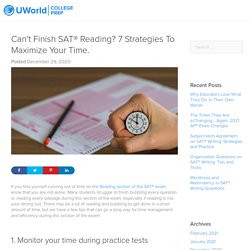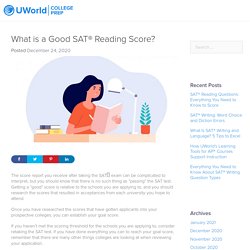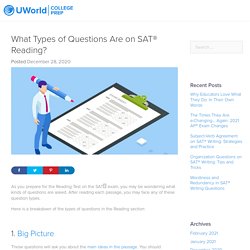

Uworld
5 Tips for Possessives and Apostrophes on SAT® Writing. What Are Possessives?

A possessive is used to display an item’s ownership. Some questions on the SATⓇ exam will ask you about possessive nouns and possessive pronouns. Here is what you need to know: Possessive Nouns Displaying a noun’s ownership is quite simple. If the noun is singular, all you will need to do is add an apostrophe and an “s” to the end of the word.Example: The movie’s ending was surprising. If a noun is plural and does not end in “s,” you will do the same thing.Example: The women’s basketball team won the championship game. If a noun is plural and it does end in “s,” all you need to do is add an apostrophe to the end of the word.Example: The parents’ cars are all parked in the parking lot. Tips 1. Watch out for indefinite pronouns like “something,” “nobody,” “few,” “both,” or “any.”
A singular indefinite pronoun (hint: look for words that end in “-body” or “-one”) needs to agree with a singular possessive. Here is an example:Everyone needed his or her water after the game. 2. Tips for Adjectives vs. Adverbs in SAT® Writing. Adjectives Adjectives are words used to describe or alter nouns and pronouns.

SAT® Vocabulary Tips: Breaking Down Word Roots, Prefixes, and Suffixes. SAT® vocabulary questions can be tricky, but if you can break down the root, prefix, and suffix of the word in question, the definition may become more apparent.

Break the word down, and use the parts’ definitions to make a guess about the meaning of the whole word. Here is a list of common root word definitions that can help you with SAT vocabulary: What Is SAT® Writing and Language? 5 Tips to Excel. The Writing and Language section of the SATⓇ test assesses your skills in editing and improving errors and weaknesses.

After reading a passage, you will answer questions about improving the main points, grammar, punctuation, word choice, structure, or tone. To succeed with these questions, you will need to pay attention to the context’s effect on a sentence or word’s function. The results you receive from the Writing and Language section are combined with your results from the Reading section, then scaled to a Reading and Writing Score between 200 and 800 points. What to Prepare This section tests your command of evidence and your skills with words in context. Command of Evidence Questions Command of evidence questions will ask you to assess possible improvements in the development of an argument.
Words in Context Questions Words in context questions will ask you to assess the diction in a provided passage. SAT® Writing: Word Choice and Diction Errors. What Is a Diction Question?

Diction and word choice error questions test your ability to assess the meanings of words in various circumstances. SAT® Reading Questions: Everything You Need to Know to Score. After reading each passage in the Reading section of the SATⓇ test, you will answer 10 to 12 questions.

Here are some details about the question types to help guide your expectations for test day. Reading Question Types The list below is in order from most common to least common. Big Picture Big picture questions assess your reading comprehension skills across the entire text. Evidence Support. Can't Finish SAT® Reading? 7 Strategies To Maximize Your Time. If you find yourself running out of time on the Reading section of the SAT® exam, know that you are not alone.

Many students struggle to finish bubbling every question or reading every passage during this section of the exam, especially if reading is not your strong suit. There may be a lot of reading and bubbling to get done in a short amount of time, but we have a few tips that can go a long way for time management and efficiency during this section of the exam! 1. Monitor your time during practice tests As you take practice tests, it is important to recreate a setting that is as close to the official testing environment as possible. Monitoring your time during practice tests is also a good plan when preparing for the pressures of test day. 2. UWorld College Prep. How To Get an 800 on SAT® Reading. Having a goal for a perfect 800 for the SAT Reading and Writing Score is reasonable if you are looking to get into an Ivy League school that expects a total score above 1550.

You may also be reaching for an 800 on the Reading and Writing score if your Math scores are weak. Colleges and universities will likely look at your total score before your sectioned performances. To make an exceptional impression for top schools, you will want the highest composite score possible, so perfecting one section may be something you are aiming for. If you apply to a major like English, communications, or political sciences, then a higher Reading and Writing score will set you aside from other applicants. What is a Good SAT® Reading Score? The score report you receive after taking the SATⓇ exam can be complicated to interpret, but you should know that there is no such thing as “passing” the SAT test.

Getting a “good” score is relative to the schools you are applying to, and you should research the scores that resulted in acceptances from each university you hope to attend. Once you have researched the scores that have gotten applicants into your prospective colleges, you can establish your goal score. If you haven’t met the scoring threshold for the schools you are applying to, consider retaking the SAT test. If you have done everything you can to reach your goal score, remember that there are many other things colleges are looking at when reviewing your application.
Check out what scores got this year’s freshman into your dream schools through the College Board’s tool “Big Future.” What Types of Questions Are on SAT® Reading? As you prepare for the Reading Test on the SATⓇ exam, you may be wondering what kinds of questions are asked.

After reading each passage, you may face any of these question types. Here is a breakdown of the types of questions in the Reading section: 1. Big Picture. SAT Prep: FREE Online Practice Tests & Questions.